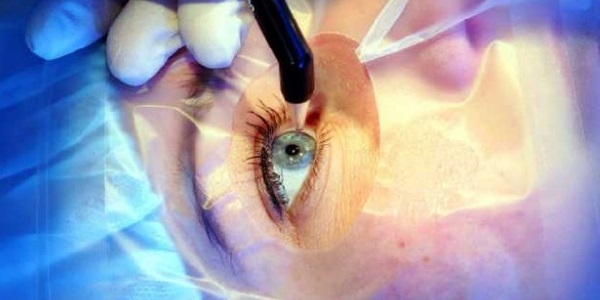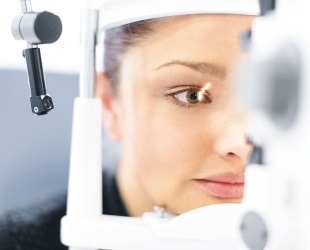
Laser correction is called in the official medicine laser keratomileusis.
This is an operation to change the shape and structure of the cornea by evaporating part of its tissues.
Here we use an excimer laser, which is characterized by the ability to rapidly evaporate organic matter in a short time.
In the course of the operation, a flap is created on the cornea giving the lens the shape that is required for the eye to clearly focus the light rays on the retina.
- 1. Indications and contraindications
- 2. Advantages of
- 3. Cons
- 4. Price
- 5. Reviews
- 6. Results of
- 7. Video
Indications and contraindications
There are two methods of procedure: LASIK andKFR.FRC is the first of the implemented methods, it is more likely to complications, LASIK is its modified version.
Laser correction is used to treat astigmatism( up to 4 dpt), myopia( up to -15 dpt) and farsightedness( up to +4 dpt).
The operation is most effective in the therapy of myopia, this is due to the fact that it is in this case that the cornea is easier to give the shape needed for the correct refraction of the rays.
Laser correction can significantly reduce the refractive power of the cornea, which is necessary for myopia, but the potential for increasing this force( which is necessary for farsightedness) is much less.

The operation does not eliminate the underlying causes of pathology, such as changing the shape of the eyeball or the dystrophy of the visual muscles. It only adjusts the cornea for these defects, changes its original biological structure.
Simply put, the surgically corrected eye surface begins to perform the function of glasses and contact lenses, eliminating the need to wear them.
Laser keratomileus is contraindicated in the following cases:
- Progressive myopia. The shape of the cornea is reliably adjusted and fixed to the stable state of the eyes, but if it significantly changes, the results of the operation are depreciated, and a new correction becomes necessary.
- Starved hyperopia. Correction can not change the cornea in such a way that it neutralizes the dystrophy of the muscles of the lens.
- Diabetes.
- Immunodeficiency.
- Too thin cornea( less than 450 microns).
- Age under 18 years - the operation is performed only on a fully formed eyeball.
- Glaucoma and cataract.
- Herpes.
Advantages of
The unique advantages of laser correction include:
| Speed | The operation is performed in 10-15 minutes, most of the time, preparatory procedures. The result comes immediately after the completion of |
| procedures. High process accuracy and automation | All data and coordinates are recorded in the computer, which is responsible for the direction and force of the laser, the influence of the human factor here is reduced to zero. |
| Low invasiveness of operation | .layers of the cornea, there is no interference in the deep tissues of the eye. No need to take strong drugs and undergo general anesthesia |
| Individual approach | The surgical plan is designed taking into account the uniqueness of the structure of the eye of each person |
| The duration of the effect | The need to wear glasses and lenses is no longer necessary |

Cons
There are a number of drawbacks to correction:

- Many postoperative limitations. The cornea becomes more vulnerable to negative external influences( especially to the effects of UV and IF beams), it is impossible to lift weights and undergo other kinds of high loads.
- Correction made at a young age, the does not protect against the development of the presbyopic in 40-60 years, in addition, it can manifest itself more unpredictably than on untouched by the surgery eyes.
- The risk of developing side effects, such as corneal opacity, decreased protective function( and subsequent damage to keratitis or herpes), eye withers.
- Despite the automation of the process, in rare cases there may be inaccuracies in the calculations of ( usually due to inaccurate pathology diagnostics), which will lead to insufficient correction and the need for a repeat operation.
- Astigmatism and farsightedness correction is not possible in all cases.
- The high price of for the most reliable correction methods.
Price
PRK is the cheapest method of correction - its average price is only 15 thousand rubles in Moscow and 5-10 thousand in the regions. The average price of an operation using the LASIK method is 20-50 thousand rubles, depending on the version of the technique.
It should be noted that clinics most often indicate prices for the therapy of one eye, so in most cases they need to be multiplied by two times.
In Ukraine, the average price of PRK is 3500 UAH, LASIK costs 7-15 thousand UAH.
Reviews

Many note that the required precautions after the operation are seriously exaggerated.
A number of users claim that people were exposed to medium( and officially contraindicated) loads after the operation and did not lead to any negative consequences.
Doctors at the forums warn that the absence of side effects in case of violation of the recommendations does not yet indicate the possibility of not observing them. The eye of each person is unique, it is impossible to say in advance how he will react to these or other postoperative loads.
Study of feedback on the effectiveness of the operation shows that most people consider correction a reliable and durable way of providing good vision without the use of glasses and lenses.
There is a nuance that, in order to obtain full information on modern methods of correction, time must pass( about 20-30 years), which because of the novelty of the methodologies has not passed yet, since if they have opposite sides, they should show themselves in the long-termterm.
Results of
Laser correction is a procedure for evaporation of a part of the corneal tissues, leading to a change in its refractive force, taking into account the structure of the eyeball.
This allows you to see well without glasses at myopia and in the early stages of hyperopia and astigmatism. The operation is painless and has a relatively small number of side effects.
But it imposes a number of restrictions on the person's way of life for several months after the intervention.
There are limitations to the operation itself - it is impossible to carry out with many systemic and eye diseases.
Video
Did you know this?
